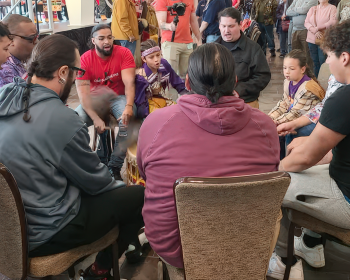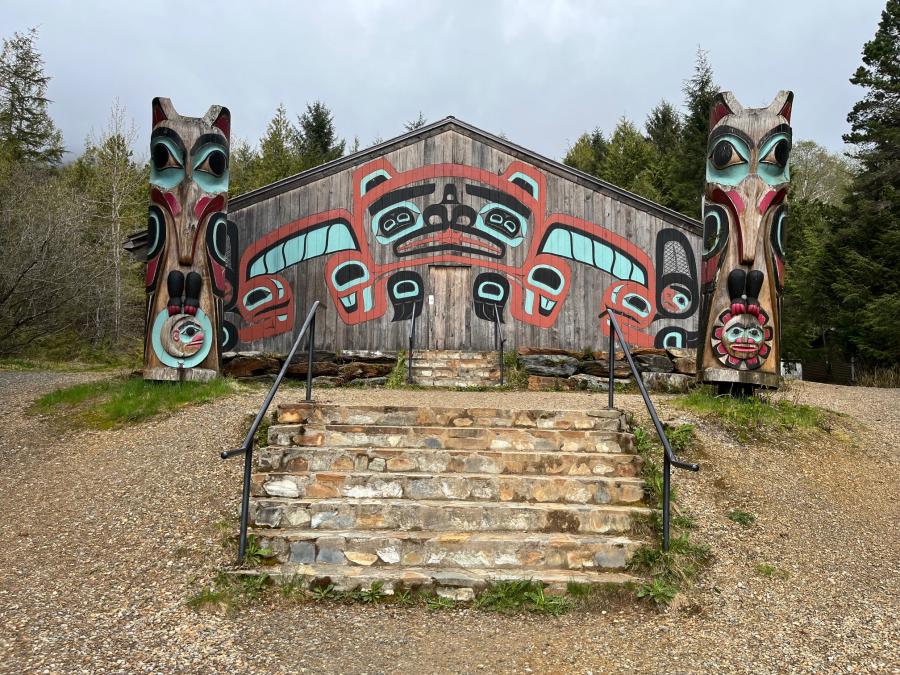
By Phoebe Farris
This exhibition of 26 Indigenous artists living in N.Y.C. is on display at the Arts Horizons LeRoy Neiman Art Center (AHLNAC), 2875 Frederick Douglas Blvd. and 148th St. from October 13 - December 19, 2014. It is a fundraiser for NITCHEN, INC., an advocacy organization for New York City’s Native American children. Curated by Nadema Agard (Cherokee/Lakota/Powhatan) and Joseph W. Kabance (Prairie Band Potawatomi), the works by 26 selected artists reflect Indigenous unity and diversity. Nadema Agard calls it an “Indigenous matrix” because the exhibition includes artists who are federally or state recognized, citizens of tribal nations that have not been formally recognized by governmental agencies, those who are self-identified, and artists who are honoring part of their heritage.
Participating artists include: Nadema Agard (Cherokee/Lakota/Powhatan), Priscilla Bell (Taino), Esteban Cabeza de Baca (Apache/Navajo/Mestizo), Robert Cangiano (Maya), Khadijah Canns (Abenaki/Cherokee), Tommy Cheng (Hawiian), Amaru Chiza (Quechua), Ermelinda Cortes (Taino), Alexie Cruz (Taino), Barbara Little Bear Delisle (Mohawk), Paul Deo (Powhatan), Shannon Flynn (Chippewa), Kae Gabrielle (Quechua/Mohawk), Guadalupe Garcia-Vasquez( Mexica), Joseph Quillsong Gullo (Cherokee), Pamela Ifandy (InterIndigenous),Tlisza Jaurique (Mexica/Yaqui) Joseph W. Kabance (Prairie Band Potawatomi), Jesi Kelley (Cherokee/Nottoway/Seminole), Karen “Aiki” Kelley (Cherokee/Nottoway/Seminole), Towanna Miller (Mohawk), James Murphy (Cherokee), Phyllis Sanfiorenzo (Taino), Barbara James Snyder (Paiute/Washoe), Surge Velez (Taino), and Marcus Zilliox (Cheyenne/Pima/Mexica).
As expressed in her Curator's statement, Nadema Agard writes, “It is said in Native Country that the men initiate the song and the women carry it. So as Co-Curator, I expanded on Mr. Kabance’s vision by naming the exhibition, Manahatta Today: Indigenous Art of N.Y.C. Manahatta was the original Algonquin Nation (Lenape) name of this great metropolis we call home, the Big Apple with an Algonquin core. The term Indigenous is the matrix that includes all categories of the original Native peoples of the Western Hemisphere and the Pacific who have been born here or who have lived here or continue to live here and who bring their very special and unique cultural perspectives and practices." She concludes her statement with "These artists reflect an Indigenous unity and diversity simultaneously with their unique statements that often cross borders of identity and ethnicity; of time past, present and future; of the cosmology and spirituality; of beauty and painful sadness but most of all their work emanates the love that is part of a vast holiness the Lakota call Wakan Tanka. O Mitakuye Oyasin (we are all related).”
Co-Curator Joseph W. Kabance states that, “My motivation and vision for initiating this particular art exhibition was to bring together the New York City Native American/Indigenous community and their artists. Here, Native American/Indigenous artists have the opportunity to show their varied art forms, media and styles for the viewer to see the kinds of works being created by these N.Y.C. artists. It is also an opportunity to view if the work is traditional or contemporary or whether the art work does or does not look the art of or fit into the viewer’s idea of a Native American/Indigenous aesthetic, style or presentation. Is the art boxed in, defined or stereotyped? Does the work reflect core cultural values or elements identifiable as one might consider Native themed or does it appear more like mainstream art? These are some of the questions that I expect to be raised by this First Native American/Indigenous art exhibition/fundraiser for NITCHEN.”
Pamela Ifandy’s “Seminole Woman”, 2014, mixed media on paper is a vibrant, colorful portrait that includes only half of the woman’s head and upper body. The patchwork blouse is easily recognizable as Seminole clothing so even without the title many viewers know what nation the woman represents. Of mixed heritage, Ifandy describes her art as “a piecing together and reclaiming of my inter-Indigenous heritage from the perspective of one born and raised in multicultural N.Y.C., several generations removed from my Indigenous ancestral communities”. The tiny pieces of fabric stitched together to create traditional Seminole clothing and a face partially obscured allude to Pamela Ifandy’s piecing together her heritage.
Mother/Daughter artist team Karen “Aiki” Kelley and Jesi Kelley are well represented in Manhatta Today, shown together but with different aesthetic visions. Daughter Jesi studied graphic design and illustration at Pratt Institute and designed the exhibit’s invitation. But photography is her favorite medium. “I take pictures to tell stories of people, of places, of change. The pictures I take at pow wows or in Manhattan reflect the story of me and the stories I have learned”. The photo, “Proud Mama/Seminole”, 2008, Giclee print, presents a rear view of a mother and daughter dressed in colorful regalia at a pow wow. The other photo "Eastern Woodland, 2008,Giclee Print captures the movements of a young male dancer in regalia.
In contrast, mother Karen Kelley’s works are more timeless with scenes that can be interpreted as contemporary, from the 1800’s, or from a more mythic past. “Ghost Dance for Harlem”, 2007, watercolor and acrylic on paper, 20x36”, resonates with symbolism from the 1889-1890 Ghost Dance religious movement; a spiritual gathering that involved dancing to reunite the living with spirits of the deceased to bring peace and prosperity to Native peoples. It was inspired by Wovoka’s (Paiute) prophecy of a means to end white expansion. In Kelley’s painting the sky is inhabited by two large birds, bigger than the central figure of the ghost dancer and also includes stars, crosses, and a crescent moon. The bottom of the painting incorporates images of buffaloes, profiles of Indian men, and a turtle, all well recognized Native symbols. But what distinguishes this painting from other ghost dance imagery is the modern four story Harlem apartment building. Ghost Dancers in the late 1800’s hoped to stop white expansion and have Native lands returned. Currently, white gentrification in Harlem is displacing long term Black and Latino residents.
Also by Karen Kelley, “Coyote Woman Went to Venice with a Few of Her Friends”, incorporates the traditional coyote trickster into a modern setting at the Venice Art Biennale. A female trickster in high heels kneels on the floor of a gallery with a hanging painting on the background wall while a transparent eagle hovers close by. Like “Ghost Dance for Harlem”, the artist includes the past and the present, living beings, and spiritual entities.
Tommy Cheng is a master puppeteer currently living in N.Y.C. who grew up in O’ahu, Hawai'i. Cheng has worked as a voicing actor for the National Theater of the Deaf, in Off-Off Broadway, and with the Jim Henson International Puppet Theater in NY. In 1991 he began working as a puppeteer with the Children’s Museum of the Native American, presenting Native American legends and stories. Now he directs it under the new name, the Children’s Cultural Center of Native America. In addition to puppetry Cheng is a painter, specializing in portraits of people from Hawaii, including members of the Hawaiian royal family.
Cheng’s eight figures puppet-sculpture, “The Royal Hawaiians: From Kamehameha Nui to Lili'uokalani ” is composed of bust sized men and one woman sitting in orange chairs, dressed in colonial era Western clothing and adorned with gold military badges, sashes, and jewelry. With their brown skin, black hair, and full features they appear to be the indigenous Hawaiian royal family who have assimilated Western customs by choice, force or a combination of factors. Indigenous Hawaiian sovereignty is still a contemporary issue for activists but seldom covered in mainstream media.
Artist Phyllis Sanfiorenzo describes “Bird Man" and "Huracan Lovers,” oil, shadow box frame, and mixed media as part of a series “defined by the notion of what if an evolved untarnished Taino culture somehow modernized. "Huracan Lovers" is in Puerto Rico, where a tenement style Taino Bohio houses a beautiful young woman serenaded by her suitor." Sanfiorenzo speaks of her work in terms of the European Renaissance era meeting Latin American magical realism.”The paintings are to entice the viewer through a telescopic view of a magical existence, modernized and untainted.”
Surge Velez, also Taino, is a self-taught painter inspired by Zdzislaw Beksinski and Gerald Brom. Velez’s works depict the catastrophic, “unusualness, dark and graphic strangeness.” According to Velez, his painting “East Field” is “A vision of the future of New York City suffering from devastations such as overpopulation and biohazard outbreaks. The rivers that surround Manhattan Island have dried up and become altogether, possibly the world’s biggest cemetery, which contains the unknown. This was inspired by Potter’s Field, located on Hart Island.” With its’ dark brooding coloring, broken bridge, huge black crow, barbed wire, and rows of tombstones, viewers of “East Field” can definitely sense its’ apocalyptic mood or theme.
Shannon Flynn describes her creative process as a need for wholeness in a fractured world. “I often feel that living beings speak to me with their colors, shapes, and movements. Drawing and painting is a conversation or a dance in which I listen and move in response to information from these entities. I often do not remember drawing, only that I have met someone marvelous, whether it be a tree, a fish or another human." Flynn’s portrait, “Hynpotized Lobster”, is one of those entities. She hopes that “sharing these portraits will awaken viewers to the sacred essences of their subjects.”
Esteban Cabeza de Baca grew up in the border town of San Ysidro, CA in a house literally on the border where his family could walk a few blocks to Mexico. During the 90’s his family migrated to Denver, CO and Cabeza de Baca moved to NY in 2007 where he eventually earned a BFA from The Cooper Union and a MFA from Columbia University. He describes his family as Latino and Indigenous, dealing with ever changing immigration policies.”I grew up seeing walls all the time”. Perhaps that is why he prefers to paint outdoors, engaging the public on the streets, setting up space with art supplies, an easel, and portable bench. Esteban identifies as an “observational painter merging the unconscious with consciousness…expressing the scars of colonialism on the American landscape.” This oil painting reflects that merging of the unconscious and consciousness with its unusual proportions for the spider, the web, and sun. Although the objects are representational and painted from close observation, the artist’s choice of scale indicates a feeling of unconsciousness with imagery that is realistic but dreamlike.
The opening celebration for “Manahatta Today” also included a honoring ceremony for Reverend Robert Chase, Founding Director, Intersections International; and Kamala Cesar, Founding Director, Lotus Music and Dance, and Director of the annual festival, Drums Along the Hudson. Honorees were presented with the first Annual Nitchen Wanishi Award. "Wanishi" means thank you in Lenni Lenape and these individuals were chosen for their dedication to NITCHEN and the Native American community in N.Y.C. "Nitchen" means our children in the Lenni Lenape language. Proceeds from the art sales will help continue the mission to advocate for Native American children.
For more information about upcoming and related events and gallery hours, contact Marline Martin, Director of Art Horizons LeRoy Neiman Art Center at 212/862-2787 or Irma Laguerre, Director of Nitchen's Children's Cultural Center of Native America at 646/330-2125 TEL 646/707-0414 FAX or E-Mail at Nitchen.cccona@gmail.com.
— Phoebe Farris, Ph.D. (Powhatan-Renape) is the arts editor for the CSQ. She is a professor emerita of Purdue University.














